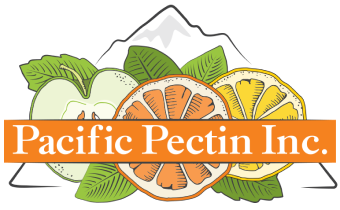Your Pectin Partner Since 1986
Gummy FAQs and Terminology
Quick Jump
Dive deeper into the art of gummy making with one of our professionals.
Send us a message and we're happy to help you.
Welcome to Our Gummy Making Journey!
At Pacific Pectin, we cherish every question you bring to us. Whether you’re a seasoned gummy manufacturer or a home cook eager to understand the magic behind these delightful treats, we’ve compiled a treasure trove of answers and insights. Dive in!
Terminology
The terms below are a great reference to skim through before diving into the FAQ section. If you’re familiar with these terms and the role they play in the gummy-making process, we believe you’ll be much more likely to succeed in your journey to pectin perfection!
Pectin: A natural thickening agent extracted from fruits, crucial for gelling gummies.
HM Pectin: High Methoxyl (HM) Pectin requires high sugar content and acidic conditions to gel.
LM Pectin: Low Methoxyl (LM) Pectin is calcium reactive and thus requires calcium to gel.
Amidated Pectin: When pectin undergoes the amidation process, it changes the pectin’s functionality causing it to be calcium reactive. Amidated pectin is not considered organic compliant.
Non-Amidated Pectin: Obviously, non-amidated pectin does not go through the amidation process and is thus still sugar/acid reactive and considered organic compliant.
Gelation: The process of forming a gel-like structure, essential in gummy making.
Hydration: The step where pectin absorbs water before it’s dissolved, key for a smooth texture.
Brix: The measurement of soluble solids in a liquid. A soluble solid is any ingredient that goes into a solution and maintains its structure. Examples include pectin, sugar, acids, etc. Refractometers can be used to measure brix!
pH: A measurement of acid content. The pH scale ranges from 0 to 14…0 being extremely acidic and 14 being very basic. Using a pH meter will help you measure pH in your individual recipe.
Mixing: Combining pectin with sugar and fruit juice to start the gummy magic.
Heating: Cooking the mixture to activate the pectin.
Molding: Pouring the hot mixture into molds to set into fun shapes.
Cooling: Letting the gummies cool to solidify into chewy delights.
Demolding: Gently removing the gummies from the molds, ready to be enjoyed!
Gummy-Related FAQs
What is Pectin?
Pectin is a natural, plant-derived substance primarily obtained from fruits, particularly citrus fruits. What makes pectin appealing is its inherent connection to nature, as it is designed to preserve the natural qualities of food. In contrast to gelatin, a common alternative to pectin, which is derived from boiling animal bones, pectin has gained notable popularity among gummy makers and manufacturers in recent years.
Should I use pectin over other gelling agents?
Choosing pectin over other gelling agents is advantageous for several reasons. Pectin not only helps maintain the natural flavor of products but also aligns with organic and natural labeling claims. Pectin-based gummies provide a cohesive and firm texture, ensuring a satisfying bite. Additionally, they excel in factors such as flavor release, acid stability, pH working range, and heat stability, making pectin a superior choice for gelling compared to other alternatives.
How does pectin differ from gelatin in making gummies?
While gelatin is derived from animal collagen, pectin comes from citrus fruit peels. Pectin gummies offer a more appealing, often described as more natural and fruit-like, texture compared to gelatin gummies.
I’ve heard pectin is hard to work with when making gummies! Is this true?
Making gummies can be perceived as challenging, but it’s more of an art form. Challenges may arise during the setting process if the correct procedure is not followed. However, by diligently adhering to our recommended steps, especially regarding cooking temperature, sugar and citric acid levels, and proper cooling, you can overcome any difficulties and achieve the perfect gummy outcome.
Are pectin gummies vegan-friendly?
Pectin gummies are considered vegan-friendly! Non-amidated pectin is considered both vegan and organic-compliant.
How do I use your pectin to make gummies?
Follow our detailed recipe and usage instructions provided in the gummy vault or in our gummy recipe book! Ensure precise measurements, temperatures, and mixing techniques for optimal results.
What ingredients are needed for a basic pectin gummy bear recipe?
Key ingredients include pectin, sugar, citric acid, water, flavorings, coloring, emulsifiers, and additional sugar for coating.
What’s the role of citric acid in making pectin gummies?
Citric acid plays an essential role in your gummy recipe in that it increases the acidity of the recipe thus lowering your pH to achieve that perfect gelling range (3.0 to 3.5). As citric acid is added to your batch, the pH will drop. The flavor of citric acid also compliments and amplifies your existing flavor.
What is High Methoxyl (HM) pectin, and why is it preferred for making gummies?
HM (high-methoxyl) pectin, when heated with the right acidity and sugar levels, efficiently gels gummy mixtures, making it a popular choice for creating pectin gummies that don’t melt and have a satisfying chewy feel.
Why are my gummies too soft?
Soft gummies can be a result of multiple variables. It’s best to start by first ensuring you hit your target setting parameters, brix and pH. You want to end the cooking procedure between 75-84% brix with a final pH between 3.0 and 3.5. The brix cannot end below 75% or the gel will fail to set firm enough to pull from the molds. If the final pH is above 3.5, the batch is lacking the necessary available acids required to form a gel and you will want to increase the citric acid usage on the next batch.
Low pectin usage and or a long cooking procedure can result in a soft gummy. Cooking procedures that are over an hour from beginning to end will likely have an increased pectin usage.
Why are my gummies too hard?
Hard gummies are typically a result of low syrup usage. You can make a gummy without syrup and just sugar, however, the gummy will become very hard within a couple of days and if the syrup usage is low (below 20%). You might see these effects a couple of weeks after the production date. If the gummies are too firm right out of the molds, you can reduce the syrup usage to 25% as well as reduce the pectin usage until the desired firmness is achieved.
Why do my gummies taste bitter and how do I fix it?
The bitterness in CBD/THC gummies, vitamin gummies, and medicated gummies may stem from certain ingredients. To address this issue, incorporating flavor modifiers, such as bitter blockers, becomes crucial. These modifiers effectively mask the unpleasant bitter taste, providing a solution to enhance the overall taste and improve the consumer experience with your gummies.
Can I use pectin for sugar-free or low-sugar gummies?
Yes, our Pacific Sugar-Free Gummy Pectin can be used for sugar-free or low-sugar gummy recipes. However, adjustments to the recipe may be needed, so refer to our guidelines for sugar substitutes and modifications.
Why does my gummy develop a hard exterior layer, and how do I prevent it?
If your gummies are forming a hard exterior layer, it’s often due to imbalanced sugar and syrup levels in your formula. Adding MORE SYRUP (such as glucose, tapioca syrup, or corn syrup) helps prevent this by increasing the gummy’s moisture retention and elasticity, allowing it to set evenly without drying out on the surface. On the other hand, adding MORE SUGAR can worsen the problem, as it reduces the gummy’s ability to hold moisture and leads to the crusty texture you’re experiencing. For smooth, well-set gummies, focus on adjusting your syrup-to-sugar ratio, leaning toward more syrup for better results.
How do I prevent my gummies from sticking to the molds?
Lightly coat your molds with a food-grade mold release spray or a small amount of coconut oil before pouring the mixture. Allow the gummies to set completely before attempting to remove them.
How do you troubleshoot pectin gummies that won’t set?
Frequent issues arise from inadequate sugar or excessively low cooking temperatures. It is crucial to ensure that the pan reaches the required temperature, and we recommend using induction burners for optimal results.
What’s the ideal temperature for making pectin gummies?
The best temperature is typically around 230°F, allowing the sugar mix to fully incorporate with pectin and other ingredients. Consistent stirring is crucial to prevent lumps.
Why are my gummies wet and sticky?
If your gummies are overly tacky, ensure the final pH is at or below 3.5. If gelled enough to remove from the molds, a high-pH gummy will be very tacky.
It is the safest practice to allow the gummies to cure for 24 hours at 30-35% room humidity and 70*F before sugar coating or packaging them. In some cases, packaging the gummies before they have fully cured will capture the moisture being sweat out and this will make the gummies look wet.
My gummies are sticking together in their packaging! Why is this happening?
The issue of your gummies sticking together in their packaging may arise from the lack of a proper coating. To remedy this, ensure to coat your gummies after removing them from the molds. Various coating options are available for different preferences. For a sweet final texture, coating with table sugar or powdered sugar is recommended. Those aiming for sour gummies may opt for a citric acid/sugar mix, while others seeking a polished finish can use a combination of carnauba wax and flavorless oil. Alternatively, a nonstick, matte finish can be achieved by coating with a mixture of cornstarch and powdered sugar.
Can I mix different flavors using the same batch of pectin?
Yes, you can mix flavors within the same batch. However, be cautious about overcomplicating the recipe, as certain flavors may overpower others. Experiment in small batches to find the perfect balance.
How should I store your pectin, and what is its shelf life?
Store our pectin in a cool, dry place, away from direct sunlight. Ensure the packaging is properly sealed after each use. The shelf life for our pectin is 24 months!
What if I have allergies or dietary restrictions?
Our premium pectin is free from common allergens, but always check the product labels for specific information. If you have concerns, consult with a healthcare professional.
Do you offer bulk discounts for larger orders?
Yes, we provide bulk discounts for larger quantities. Contact our customer support team for customized quotes and assistance with your bulk order. ([email protected])




